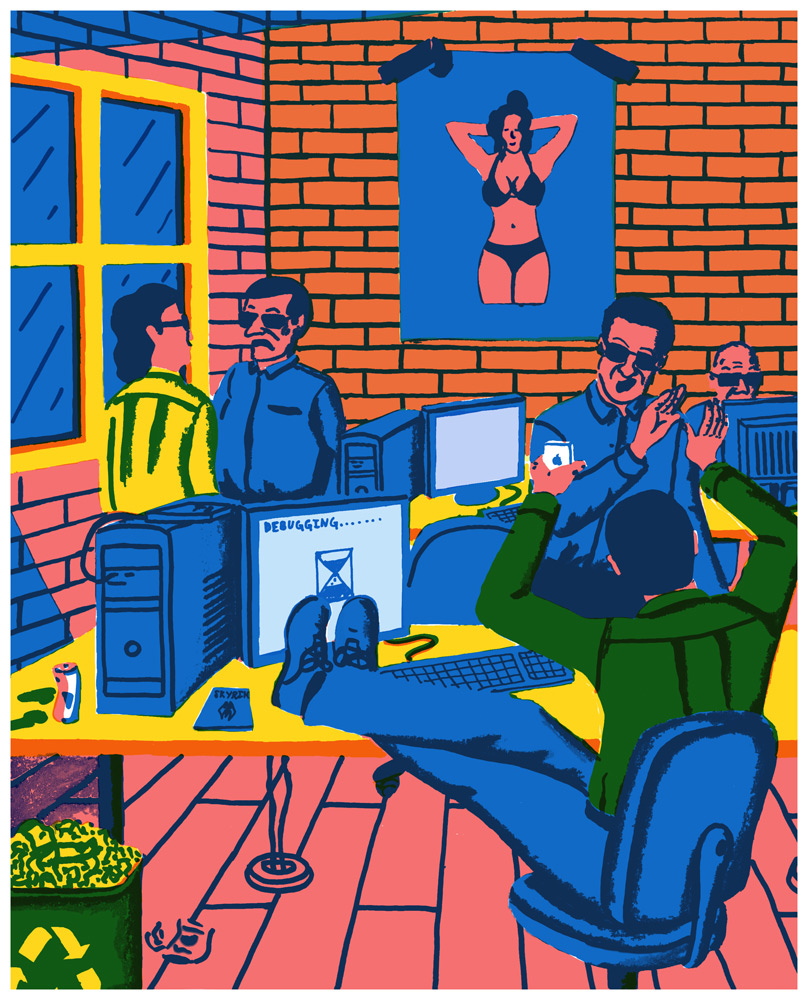Career Inequality
As women make some serious advances in traditionally ‘male’ jobs, what will the long-term consequences of this rebalancing be?

When India’s Mars mission entered the planet’s orbit in 2014, the control room was crowded with triumphant faces – yet the story that captured the world’s attention wasn’t about a successful, highly technical mission, but rather the number of women involved on the project. Images of the programme’s many women scientists celebrating the achievement went viral – helping to shake off stereotypes of ‘women’s work’ and inspiring thousands of girls to dream of joining the exploration of space.
That so many women have an integral role in a space programme shouldn’t be that striking. Over the past year, a record 100 women were voted into the US Congress, women began to out number men at medical and business schools, and they’re starting businesses at a faster rate than men. But, despite a few high-profile examples, there is still a sizeable gap when it comes to career equality.
To detail all of the ways in which women are under-represented in key industries would take more pages than this magazine has, but in the spirit of brevity, some key statistics: companies with women CEOs only got 3% of venture capital funding between 2011 and 2013, according to research by the Diana Project. In 2012, women accounted for 49% of the bottom 99% of earners in the US; but for just 11% of the top 1%, according to a report compiled by the Federal Reserve Bank of Minneapolis. Since 1901, 575 men have received a Nobel Prize in science, compared with only 17 women. Women make up only 3% of creative directors in advertising, take up only 4% of engineering apprenticeships, and only 1% of UK jobs in STEM fields (science, technology, engineering and mathematics) are held by women – the lowest proportion in Europe.
The huge inequality in these important, innovative and lucrative industries could be preventing many women from having a stake in the future economy, and it’s largely down to old-fashioned sexism, according to Anna Beninger, research director of equality campaigning organisation Catalyst. “Tech-intensive industries have a very poor reputation for supporting gender diversity,” she says.
“The image of ‘brogrammer’ culture reigns in technology,and the old boys’ club in oil and gas companies. And it turns out that this reputation is well-deserved, as we saw recently with the release of workforce statistics from top technology firms including Facebook, Twitter, Google and Apple.” Each of these companies’ self-reported gender balance is around 30% female to 70% male, but the proportion of women in the technological heart of some of these businesses drops to as little as 10%.
“To give you an example of how far behind these industries are, a senior female executive at a prominent oil and gas company recently said the best advice she would give to up-and-coming women in her industry is to use a black coffee mug in the office because it doesn’t show lipstick marks,” says Beninger. “That was shocking to hear.”
While this may sound like an extreme example, when women are not welcomed into these key industries, it could short-circuit the economy. Despite being some of the fastest-growing areas of employment, they have a seriously undersupplied talent pipeline; in the UK, there’s an annual 40,000 shortfall in STEM graduates sufficiently qualified to fill key roles. It stands to reason that businesses must look beyond the stereotypes of macho engineers or geeky guys to fill the gap.
But the tide is beginning to turn. The G20 summit has stated that women’s participation in the workforce is the biggest untapped resource in boosting the global economy. The Women’s Business Council estimates that the UK could add 10% (£150bn) to its GDP by 2030 if all the women who wanted to work were employed.
Fortune 500 companies with three or more female directors saw at least a 66% increase in return on invested capital
As well as boosting national economies, having more women in the workforce helps individual companies too. According to a report by the Anita Borg Institute, Fortune 500 companies with three or more female directors saw at least a 66% increase in return on invested capital, and an increase of at least 42%return on sales. McKinsey’s annual Women Matter reports have consistently found that companies with significant numbers of women in senior management perform better both financially and organisationally.
A study for the Conference Board of Canada discovered that organisations which foster gender equality at all levels have better bottom-line performance, lower staff turnover and are more appealing to talented workers. As a result, governments and businesses are taking workforce equality seriously, and a wave of new initiatives are tackling the gender gap. It’s now about more than just recruitment or promotion quotas, which can cause resentment among men and women – instead, companies and government projects are focusing on holistic approaches to career equality, from positive action in the hiring process to mentoring, peer networks and more flexible working practices.
The number of role models for women in senior positions is decidedly small, with extraordinary women such as Sheryl Sandberg and Hillary Clinton regularly highlighted as inspirational and barrier-breaking. But studies show that ultra-high-achievers are less inspirational for women than peers, or those just a few years ahead in education or work. According to Ann Francke, chief executive of the Chartered Management Institute: “Without accessible, inspiring women highlighted in the public eye, it’s no surprise we’re lacking a pipeline of talented women aiming for top jobs. If men in our workplaces are inherently biased towards taking their lead from the men in they're lives rather than the women, it’s unlikely they’re championing and nurturing their female and male employees equally”.
Many of the world’s biggest companies are now introducing mentoring programmes to give junior employees guidance and inspiration from women higher up the ladder. And where those support networks don’t exist, women are creating their own industry-spanning networks to support each other and share experiences. Leading groups include TechLady Mafia and The Li.st (technology), WISE (engineering), EnterprisingWomen (entrepreneurship), the 3% Conference and its associated organisation (advertising) and Women On Boards(senior management).
Other businesses are helping to promote career equality by working with women-owned enterprises. Women-run businesses now make up 10% of Marriott’s supplier base, accounting for over $257m of the brand’s spending every year. Marriott is now working with leading NGOs WEConnect International and VitalVoices to train 15,000 female business owners and will spend $1.5bn with their companies by 2018.
The Coca-Cola Company is also attempting to level the playing field for working women, through its 5by20 initiative. “When we invest in women entrepreneurs and provide access to business skills training, finance and mentors through 5by20, we are in fact investing in our own business. We’re convinced that greater women’s empowerment and entrepreneurship around the world will result in the growth of our business and help us reach our long-term business goals,” says Charlotte Oades, global director of Women’s Economic Empowerment.
Computing giant Intel is also contributing to the development of a larger and stronger pool of skilled workers. The company recently announced a $300m investment to help build a more diverse pipeline of engineers and computer scientists, to support hiring and retaining more women, and to fund programmes that boost positive representation within the technology and gaming industries.
In the all-important STEM industries, companies and campaigners are having to take a multi-prong approach to inspire more women to explore STEM careers. Girls are being encouraged to think about pursuing a STEM career: new governmental and industry initiatives aim to showcase the diversity of careers for women through outreach projects in schools and apprenticeships for girls. Women working at engineering giant Arup act as ambassadors for the industry, giving talks in schools and universities and appearing at the Big Bang Fair, an event for young scientists and engineers. JCB is promoting its apprenticeships to young women, taking on a record number of female apprentices in 2014 – nine girls out of its intake of fifty nine.
But improving equality in STEM requires more than promoting its employment opportunities – girls need to be engaged in subjects like maths and science at an early age to gain the skills required in these highly technical fields. A raft of governmental and industry initiatives have been promoting science and maths less as ‘boys’ subjects’ and more as life skills. Organisations such as Women Into Science and Engineering(WISE), the UK government’s Tomorrow’s Engineers campaign, and the ScienceGrrl programme are helping to improve education about the diversity of STEM’s applications, from design and construction to astrophysics, app development and town planning.
Outside school, summer camps and after-school clubs such as Girls Who Code help girls gain confidence in building, designing and programming. For an even younger cohort, GoldieBlox is a range of mechanical toys aimed at girls, teaching them how to use science and technology as they play.
A lot of these projects are beginning to take effect. The number of women completing a BTEC in engineering grew 130% between2004 and 2012 (although the gain was built on a very low initial base), while interest in civil engineering as a career grew 10% among women between 2007 and 2013, according to a survey by Cambridge Occupational Analysts. The proportion of girls studying STEM subjects is rising faster than the proportion of boys, and this trend, if it continues, augurs well for women in the STEM-led future.
What else does this mean for the future? Research suggests that a more diverse workforce is more productive, more creative and more innovative. Research by Scott Page at the University of Michigan and Lu Hong of Loyola University shows that diverse groups significantly outperform homogenous ones, especially when it comes to innovation. Likewise, a recent study by researchers at Cornell University found that mixed-sex groups generate better ideas than single-sex groups. “Clients want diversity of thought from us,” notes Vicky Evans, who oversees inclusion and diversity at Arup in Europe. “They want to know we have the best talent who are giving the best solutions. They increasingly demand diverse project teams to ensure we have different types of thinking.”
The realisation that career equality leads to more fulfilled workers, stronger economies and more profitable, more innovative businesses means there is an incentive for all sides to work together to finally close the gender gap at work. But the momentum must be maintained. As Evans comments; “The future’s bright, but there’s still a lot of work to do.”


